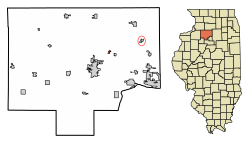Dover, Illinois
Dover is a village in Bureau County, Illinois, United States. The population was 168 at the 2010 census.[3] It is part of the Ottawa Micropolitan Statistical Area.
Dover, Illinois | |
|---|---|
Village | |
 Location of Dover in Bureau County, Illinois. | |
.svg.png) Location of Illinois in the United States | |
| Coordinates: 41°26′7″N 89°23′45″W | |
| Country | United States |
| State | Illinois |
| County | Bureau |
| Townships | Dover, Berlin |
| Area | |
| • Total | 0.27 sq mi (0.71 km2) |
| • Land | 0.27 sq mi (0.71 km2) |
| • Water | 0.00 sq mi (0.00 km2) 0% |
| Elevation | 741 ft (226 m) |
| Population (2010) | |
| • Total | 168 |
| • Estimate (2019)[2] | 153 |
| • Density | 560.44/sq mi (216.66/km2) |
| Time zone | UTC-6 (CST) |
| • Summer (DST) | UTC-5 (CDT) |
| ZIP Code(s) | 61323 |
| Area code(s) | 815 & 779 |
| FIPS code | 17-20526 |
| GNIS ID | 2398743 |
| Wikimedia Commons | Dover, Illinois |
History
Dover was platted in 1833, and named after Dover, New Hampshire, the native home of a first settler.[4] A post office has been in operation at Dover since 1839.[5] Joseph R. Peterson (1904–1967), Illinois lawyer and state legislator; served as mayor of Dover in 1929 and 1930[6]
Geography
Dover is located at 41°26′7″N 89°23′45″W (41.435327, -89.395830).[7]
According to the 2010 census, Dover has a total area of 0.26 square miles (0.67 km2), all land.[8]
Demographics
| Historical population | |||
|---|---|---|---|
| Census | Pop. | %± | |
| 1850 | 103 | — | |
| 1860 | 362 | 251.5% | |
| 1870 | 304 | −16.0% | |
| 1880 | 239 | −21.4% | |
| 1890 | 220 | −7.9% | |
| 1900 | 247 | 12.3% | |
| 1910 | 181 | −26.7% | |
| 1920 | 165 | −8.8% | |
| 1930 | 155 | −6.1% | |
| 1940 | 155 | 0.0% | |
| 1950 | 191 | 23.2% | |
| 1960 | 171 | −10.5% | |
| 1970 | 176 | 2.9% | |
| 1980 | 213 | 21.0% | |
| 1990 | 163 | −23.5% | |
| 2000 | 172 | 5.5% | |
| 2010 | 168 | −2.3% | |
| Est. 2019 | 153 | [2] | −8.9% |
| U.S. Decennial Census[9] | |||
As of the census[10] of 2000, there were 172 people, 62 households, and 53 families residing in the village. The population density was 641.6 people per square mile (246.0/km2). There were 68 housing units at an average density of 253.7 per square mile (97.2/km2). The racial makeup of the village was 99.42% White, and 0.58% from two or more races. Hispanic or Latino of any race were 0.58% of the population.
There were 62 households, out of which 37.1% had children under the age of 18 living with them, 69.4% were married couples living together, 9.7% had a female householder with no husband present, and 14.5% were non-families. 11.3% of all households were made up of individuals, and 6.5% had someone living alone who was 65 years of age or older. The average household size was 2.77 and the average family size was 3.00.
In the village, the population was spread out, with 29.1% under the age of 18, 5.2% from 18 to 24, 27.3% from 25 to 44, 24.4% from 45 to 64, and 14.0% who were 65 years of age or older. The median age was 40 years. For every 100 females, there were 112.3 males. For every 100 females age 18 and over, there were 96.8 males.
The median income for a household in the village was $41,875, and the median income for a family was $42,500. Males had a median income of $31,250 versus $20,500 for females. The per capita income for the village was $14,070. About 8.3% of families and 5.7% of the population were below the poverty line, including none of those under the age of eighteen and 29.4% of those 65 or over.
References
- "2019 U.S. Gazetteer Files". United States Census Bureau. Retrieved July 14, 2020.
- "Population and Housing Unit Estimates". United States Census Bureau. May 24, 2020. Retrieved May 27, 2020.
- "Geographic Identifiers: 2010 Demographic Profile Data (G001): Dover village, Illinois". U.S. Census Bureau, American Factfinder. Archived from the original on February 12, 2020. Retrieved November 14, 2013.
- Callary, Edward (29 September 2008). Place Names of Illinois. University of Illinois Press. p. 97. ISBN 978-0-252-09070-7.
- "Bureau County". Jim Forte Postal History. Retrieved 4 November 2015.
- 'Illinois Blue Book 1967-1968,' Biographical Sketch of Joseph R. Peterson, pg. 174-175
- "US Gazetteer files: 2010, 2000, and 1990". United States Census Bureau. 2011-02-12. Retrieved 2011-04-23.
- "G001 - Geographic Identifiers - 2010 Census Summary File 1". United States Census Bureau. Archived from the original on 2020-02-13. Retrieved 2015-08-02.
- "Census of Population and Housing". Census.gov. Retrieved June 4, 2015.
- "U.S. Census website". United States Census Bureau. Retrieved 2008-01-31.